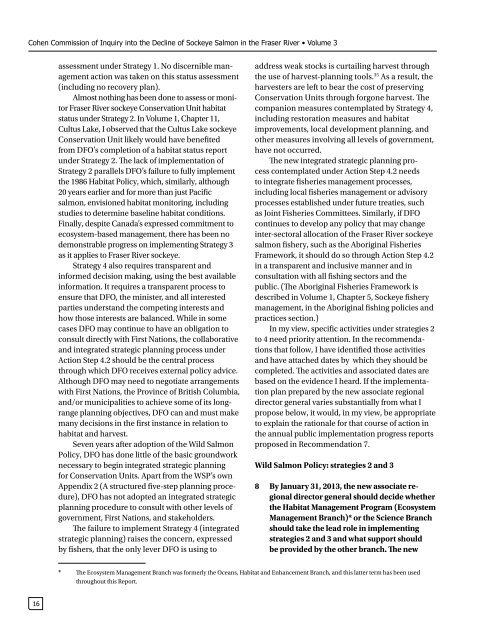CP32-93-2012-3-eng.pdf
CP32-93-2012-3-eng.pdf
CP32-93-2012-3-eng.pdf
Create successful ePaper yourself
Turn your PDF publications into a flip-book with our unique Google optimized e-Paper software.
Cohen Commission of Inquiry into the Decline of Sockeye Salmon in the Fraser River • Volume 3<br />
assessment under Strategy 1. No discernible management<br />
action was taken on this status assessment<br />
(including no recovery plan).<br />
Almost nothing has been done to assess or monitor<br />
Fraser River sockeye Conservation Unit habitat<br />
status under Strategy 2. In Volume 1, Chapter 11,<br />
Cultus Lake, I observed that the Cultus Lake sockeye<br />
Conservation Unit likely would have benefited<br />
from DFO’s completion of a habitat status report<br />
under Strategy 2. The lack of implementation of<br />
Strategy 2 parallels DFO’s failure to fully implement<br />
the 1986 Habitat Policy, which, similarly, although<br />
20 years earlier and for more than just Pacific<br />
salmon, envisioned habitat monitoring, including<br />
studies to determine baseline habitat conditions.<br />
Finally, despite Canada’s expressed commitment to<br />
ecosystem-based management, there has been no<br />
demonstrable progress on implementing Strategy 3<br />
as it applies to Fraser River sockeye.<br />
Strategy 4 also requires transparent and<br />
informed decision making, using the best available<br />
information. It requires a transparent process to<br />
ensure that DFO, the minister, and all interested<br />
parties understand the competing interests and<br />
how those interests are balanced. While in some<br />
cases DFO may continue to have an obligation to<br />
consult directly with First Nations, the collaborative<br />
and integrated strategic planning process under<br />
Action Step 4.2 should be the central process<br />
through which DFO receives external policy advice.<br />
Although DFO may need to negotiate arrangements<br />
with First Nations, the Province of British Columbia,<br />
and/or municipalities to achieve some of its longrange<br />
planning objectives, DFO can and must make<br />
many decisions in the first instance in relation to<br />
habitat and harvest.<br />
Seven years after adoption of the Wild Salmon<br />
Policy, DFO has done little of the basic groundwork<br />
necessary to begin integrated strategic planning<br />
for Conservation Units. Apart from the WSP’s own<br />
Appendix 2 (A structured five-step planning procedure),<br />
DFO has not adopted an integrated strategic<br />
planning procedure to consult with other levels of<br />
government, First Nations, and stakeholders.<br />
The failure to implement Strategy 4 (integrated<br />
strategic planning) raises the concern, expressed<br />
by fishers, that the only lever DFO is using to<br />
address weak stocks is curtailing harvest through<br />
the use of harvest-planning tools. 35 As a result, the<br />
harvesters are left to bear the cost of preserving<br />
Conservation Units through forgone harvest. The<br />
companion measures contemplated by Strategy 4,<br />
including restoration measures and habitat<br />
improvements, local development planning, and<br />
other measures involving all levels of government,<br />
have not occurred.<br />
The new integrated strategic planning process<br />
contemplated under Action Step 4.2 needs<br />
to integrate fisheries management processes,<br />
including local fisheries management or advisory<br />
processes established under future treaties, such<br />
as Joint Fisheries Committees. Similarly, if DFO<br />
continues to develop any policy that may change<br />
inter-sectoral allocation of the Fraser River sockeye<br />
salmon fishery, such as the Aboriginal Fisheries<br />
Framework, it should do so through Action Step 4.2<br />
in a transparent and inclusive manner and in<br />
consultation with all fishing sectors and the<br />
public. (The Aboriginal Fisheries Framework is<br />
described in Volume 1, Chapter 5, Sockeye fishery<br />
management, in the Aboriginal fishing policies and<br />
practices section.)<br />
In my view, specific activities under strategies 2<br />
to 4 need priority attention. In the recommendations<br />
that follow, I have identified those activities<br />
and have attached dates by which they should be<br />
completed. The activities and associated dates are<br />
based on the evidence I heard. If the implementation<br />
plan prepared by the new associate regional<br />
director general varies substantially from what I<br />
propose below, it would, in my view, be appropriate<br />
to explain the rationale for that course of action in<br />
the annual public implementation progress reports<br />
proposed in Recommendation 7.<br />
Wild Salmon Policy: strategies 2 and 3<br />
8 By January 31, 2013, the new associate regional<br />
director general should decide whether<br />
the Habitat Management Program (Ecosystem<br />
Management Branch)* or the Science Branch<br />
should take the lead role in implementing<br />
strategies 2 and 3 and what support should<br />
be provided by the other branch. The new<br />
* The Ecosystem Management Branch was formerly the Oceans, Habitat and Enhancement Branch, and this latter term has been used<br />
throughout this Report.<br />
16
















